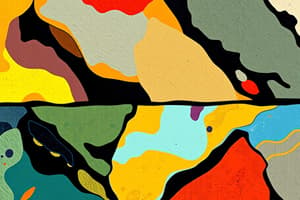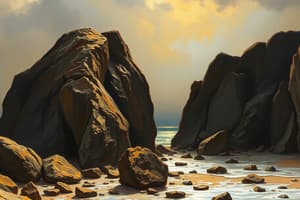Podcast
Questions and Answers
What is the Earth's crust compared to the rest of the planet?
What is the Earth's crust compared to the rest of the planet?
- Moderately thick and has a low density
- Extremely thick and has a high density
- Extremely thin and has a low density (correct)
- Moderately thin and has a high density
How old can the history of a rock span?
How old can the history of a rock span?
- Thousands of years
- Hundreds of years
- Billions of years
- Millions of years (correct)
What is the Earth's atmosphere considered to be?
What is the Earth's atmosphere considered to be?
- Not considered as part of the Earth's structure
- The heaviest shell with no distinct layers
- The first and lightest shell with its own set of layers (correct)
- The middle layer with no distinct characteristics
What are the main components of continental crust?
What are the main components of continental crust?
What type of rock is granite and how is it formed?
What type of rock is granite and how is it formed?
What is the main difference between the cooling process of magma that forms granite and lava that forms basalt?
What is the main difference between the cooling process of magma that forms granite and lava that forms basalt?
What is the process that exposes granite to new surface environments?
What is the process that exposes granite to new surface environments?
What type of rocks are formed from the compaction, cementation, and transformation of sediments?
What type of rocks are formed from the compaction, cementation, and transformation of sediments?
What makes metamorphic rocks more resistant to weathering compared to their original forms?
What makes metamorphic rocks more resistant to weathering compared to their original forms?
What does the rock cycle involve the continuous alteration of?
What does the rock cycle involve the continuous alteration of?
Flashcards are hidden until you start studying
Study Notes
The Rock Cycle and the Transformation of Granite
- Granite formed from magma deep within the Earth's crust or mantle and was uplifted to the surface due to tectonic movements.
- Rocks at the surface undergo weathering, erosion, and alteration due to different environmental conditions.
- Weathering and erosion expose the granite to new surface environments, leading to unseen processes such as expansion, cracking, and disintegration.
- Rock dust from weathering accumulates over thousands or millions of years, eventually being washed into streams and rivers as sediments.
- Sediments from the Himalayas have formed up to 20 kilometers of sediment on the ocean floor in the Bay of Bengal.
- Sediments undergo compaction, cementation, and transformation into sedimentary rocks such as sandstone, limestone, and coal.
- The collision of tectonic plates and the formation of the Himalayas led to the compression and metamorphism of rocks, resulting in the formation of metamorphic rocks like gneiss.
- Metamorphic rocks are harder, more compact, and resistant to weathering compared to their original forms.
- The rock cycle involves continuous alteration of rocks over millions of years, with pathways including the transformation of igneous rocks into sedimentary or metamorphic rocks, or their re-melting and recrystallization.
- Each piece of rock has a unique story shaped by processes both on the surface and deep within the Earth, with some dating back millions of years.
- The text concludes by introducing the topic of plate tectonics and acknowledges the importance of learning about the history of the land and its original inhabitants.
- Crash Course encourages learning about the history of the place one calls home through resources like native-land.
Studying That Suits You
Use AI to generate personalized quizzes and flashcards to suit your learning preferences.




